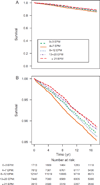Ejaculation Frequency and Risk of Prostate Cancer: Updated Results with an Additional Decade of Follow-up
- PMID: 27033442
- PMCID: PMC5040619
- DOI: 10.1016/j.eururo.2016.03.027
Ejaculation Frequency and Risk of Prostate Cancer: Updated Results with an Additional Decade of Follow-up
Abstract
Background: Evidence suggests that ejaculation frequency may be inversely related to the risk of prostate cancer (PCa), a disease for which few modifiable risk factors have been identified.
Objective: To incorporate an additional 10 yr of follow-up into an original analysis and to comprehensively evaluate the association between ejaculation frequency and PCa, accounting for screening, clinically relevant disease subgroups, and the impact of mortality from other causes.
Design, setting, and participants: A prospective cohort study of participants in the Health Professionals Follow-up Study utilizing self-reported data on average monthly ejaculation frequency. The study includes 31925 men who answered questions on ejaculation frequency on a 1992 questionnaire and followed through to 2010. The average monthly ejaculation frequency was assessed at three time points: age 20-29 yr, age 40-49 yr, and the year before questionnaire distribution.
Outcome measurements and statistical analysis: Incidence of total PCa and clinically relevant disease subgroups. Cox models were used to estimate hazard ratios (HRs) and 95% confidence intervals (CIs).
Results and limitations: During 480831 person-years, 3839 men were diagnosed with PCa. Ejaculation frequency at age 40-49 yr was positively associated with age-standardized body mass index, physical activity, divorce, history of sexually transmitted infections, and consumption of total calories and alcohol. Prostate-specific antigen (PSA) test utilization by 2008, number of PSA tests, and frequency of prostate biopsy were similar across frequency categories. In multivariable analyses, the hazard ratio for PCa incidence for ≥21 compared to 4-7 ejaculations per month was 0.81 (95% confidence interval [CI] 0.72-0.92; p<0.0001 for trend) for frequency at age 20-29 yr and 0.78 (95% CI 0.69-0.89; p<0.0001 for trend) for frequency at age 40-49 yr. Associations were driven by low-risk disease, were similar when restricted to a PSA-screened cohort, and were unlikely to be explained by competing causes of death.
Conclusions: These findings provide additional evidence of a beneficial role of more frequent ejaculation throughout adult life in the etiology of PCa, particularly for low-risk disease.
Patient summary: We evaluated whether ejaculation frequency throughout adulthood is related to prostate cancer risk in a large US-based study. We found that men reporting higher compared to lower ejaculatory frequency in adulthood were less likely to be subsequently diagnosed with prostate cancer.
Keywords: Behavioral risk factors; Ejaculation; Epidemiology.
Copyright © 2016 European Association of Urology. Published by Elsevier B.V. All rights reserved.
Figures
Comment in
-
More Is More: Disentangling the Importance of Ejaculation Frequency.Eur Urol. 2016 Dec;70(6):983-984. doi: 10.1016/j.eururo.2016.04.013. Epub 2016 Apr 23. Eur Urol. 2016. PMID: 27117750 No abstract available.
-
Re: Jennifer R. Rider, Kathryn M. Wilson, Jennifer M. Sinnott, Rachel S. Kelly, Lorelei A. Mucci, Edward L. Giovannucci. Ejaculation Frequency and Risk of Prostate Cancer: Updated Results with an Additional Decade of Follow-up. Eur Urol 2016;70:974-82: Looking Deeper: P-hacking and Some Other Bias.Eur Urol. 2016 Dec;70(6):e155. doi: 10.1016/j.eururo.2016.04.030. Epub 2016 May 5. Eur Urol. 2016. PMID: 27156130 No abstract available.
-
Reply to Herney Andrés García-Perdomo and Ramiro Manzano Nunez's Letter to the Editor Re: Jennifer R. Rider, Kathryn M. Wilson, Jennifer M. Sinnott, Rachel S. Kelly, Lorelei A. Mucci, Edward L. Giovannucci. Ejaculation Frequency and Risk of Prostate Cancer: Updated Results with an Additional Decade of Follow-up. Eur Urol 2016;70:974-82: Looking Deeper: P-hacking and Some Other Bias.Eur Urol. 2016 Dec;70(6):e156-e157. doi: 10.1016/j.eururo.2016.04.032. Epub 2016 May 5. Eur Urol. 2016. PMID: 27156131 No abstract available.
-
Re: Jennifer R. Rider, Kathryn M. Wilson, Jennifer A. Sinnott, Rachel S. Kelly, Lorelei A. Muccia, Edward L. Giovannucci. Ejaculation Frequency and Risk of Prostate Cancer: Updated Results with an Additional Decade of Follow-up. Eur Urol 2016;70:974-82.Eur Urol. 2017 Jan;71(1):e16-e17. doi: 10.1016/j.eururo.2016.05.044. Epub 2016 Jun 4. Eur Urol. 2017. PMID: 27267886 No abstract available.
-
Reply to Cédric Annweiler, Pierre Bigot, and Spyridon N. Karras' Letter to the Editor re: Jennifer R. Rider, Kathryn M. Wilson, Jennifer A. Sinnott, Rachel S. Kelly, Lorelei A. Muccia, Edward L. Giovannucci. Ejaculation Frequency and Risk of Prostate Cancer: Updated Results with an Additional Decade of Follow-up. Eur Urol 2016;70:974-82.Eur Urol. 2017 Jan;71(1):e18. doi: 10.1016/j.eururo.2016.05.052. Epub 2016 Jun 15. Eur Urol. 2017. PMID: 27317088 No abstract available.
References
-
- Soerjomataram I, Lortet-Tieulent J, Parkin DM, et al. Global burden of cancer in 2008: a systematic analysis of disability-adjusted life-years in 12 world regions. Lancet. 2012;380:1840–1850. - PubMed
-
- Gardner JR, Livingston PM, Fraser SF. Effects of exercise on treatment-related adverse effects for patients with prostate cancer receiving androgen-deprivation therapy: a systematic review. J Clin Oncol. 2014;32:335–346. - PubMed
MeSH terms
Substances
Grants and funding
LinkOut - more resources
Full Text Sources
Other Literature Sources
Medical
Research Materials
Miscellaneous


